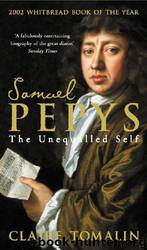Samuel Pepys by Claire Tomalin

Author:Claire Tomalin
Language: eng
Format: mobi, epub
Tags: Non-Fiction, Biography, History
ISBN: 9780141910314
Publisher: Knopf
Published: 2002-11-12T10:00:00+00:00
17. The Secret Scientist
Pepys became a member of the Royal Society in 1665 and went on to become its president in 1684. As president his name appears on the title page of Isaac Newton’s Principia Mathematica, linking him for ever with the great English scientist; but although Pepys was acquainted with Newton and had some correspondence with him, his own scientific credentials were almost nonexistent. He has been labelled ‘almost comically an arts man’ by a modern historian of science, and it is true that he was no chemist, physicist or astronomer.1 Yet Pepys was a secret scientist of a kind, if only through his scrutiny of himself, and the candid, dispassionate, regular and detailed record he made of his own physical, moral and psychological state.
He was born at the same time as a generation of outstanding scientists, all of whom were prominent within the Royal Society and personally known to him. As well as Newton (born 1642) there was the chemist Robert Boyle (1627), Christopher Wren (1632), Robert Hooke (1635) and William Petty (1623); also the physician William Croone (1633), and the older mathematicians John Wallis (1616) and William Brouncker (1620). There were many other members who were linguistic scholars, antiquarians and mere gentlemen, with no more understanding of physics and chemistry than Pepys, and like him simply eager to be part of the most distinguished club in the country, where the scientifically gifted members showed experiments and led discussion, and everyone else came along to be diverted and instructed. What Pepys valued most was without doubt the sense of belonging to the group, hearing their exchanges of ideas and theories, and feeling he was at the forefront of progressive thought.
Pepys had what was considered a good education, but it did nothing to encourage him to think scientifically: the word ‘science’ in its modern meaning did not exist. The experimental scientists among his contemporaries all looked for encouragement and training from thinkers and teachers outside the conventional academic system, and set about creating new disciplines and new systems of thought. Boyle studied abroad and with private tutors after leaving Eton. Wren started as a boy making models of the solar system, left Westminster School at fourteen and acted as an assistant to Dr Charles Scarborough, a London lecturer in anatomy, before going to Oxford, where he worked with Boyle; at twenty-five he had a chair in astronomy, not in a university but at Gresham College in the City. Newton, intended for a farmer, and Hooke, intended for the Church, were both also dedicated model-makers as children; they made mechanical toys, Hooke produced a working wooden clock and Newton made dolls’ furniture for the little girls of the village, and a model windmill with a mouse as miller.2 Hooke studied with Boyle after Oxford and Newton did some of his best work away from Cambridge. Petty, with no schooling and no money, contrived to study medicine and chemistry abroad, had a chair in music at Gresham College and one in
Download
This site does not store any files on its server. We only index and link to content provided by other sites. Please contact the content providers to delete copyright contents if any and email us, we'll remove relevant links or contents immediately.
| U.K. Prime Ministers | U.S. Presidents |
Waking Up in Heaven: A True Story of Brokenness, Heaven, and Life Again by McVea Crystal & Tresniowski Alex(37674)
Empire of the Sikhs by Patwant Singh(22974)
We're Going to Need More Wine by Gabrielle Union(18967)
Hans Sturm: A Soldier's Odyssey on the Eastern Front by Gordon Williamson(18483)
Leonardo da Vinci by Walter Isaacson(13181)
The Radium Girls by Kate Moore(11921)
Tools of Titans by Timothy Ferriss(8218)
Educated by Tara Westover(7941)
How to Be a Bawse: A Guide to Conquering Life by Lilly Singh(7391)
Permanent Record by Edward Snowden(5738)
The Last Black Unicorn by Tiffany Haddish(5558)
The Rise and Fall of Senator Joe McCarthy by James Cross Giblin(5228)
Promise Me, Dad by Joe Biden(5087)
The Wind in My Hair by Masih Alinejad(5034)
A Higher Loyalty: Truth, Lies, and Leadership by James Comey(4843)
The Crown by Robert Lacey(4723)
The Iron Duke by The Iron Duke(4291)
Joan of Arc by Mary Gordon(4013)
Stalin by Stephen Kotkin(3875)
